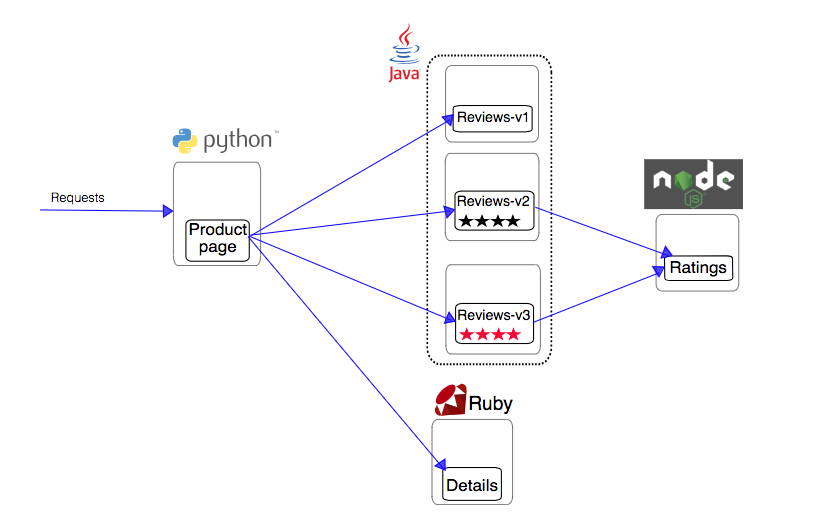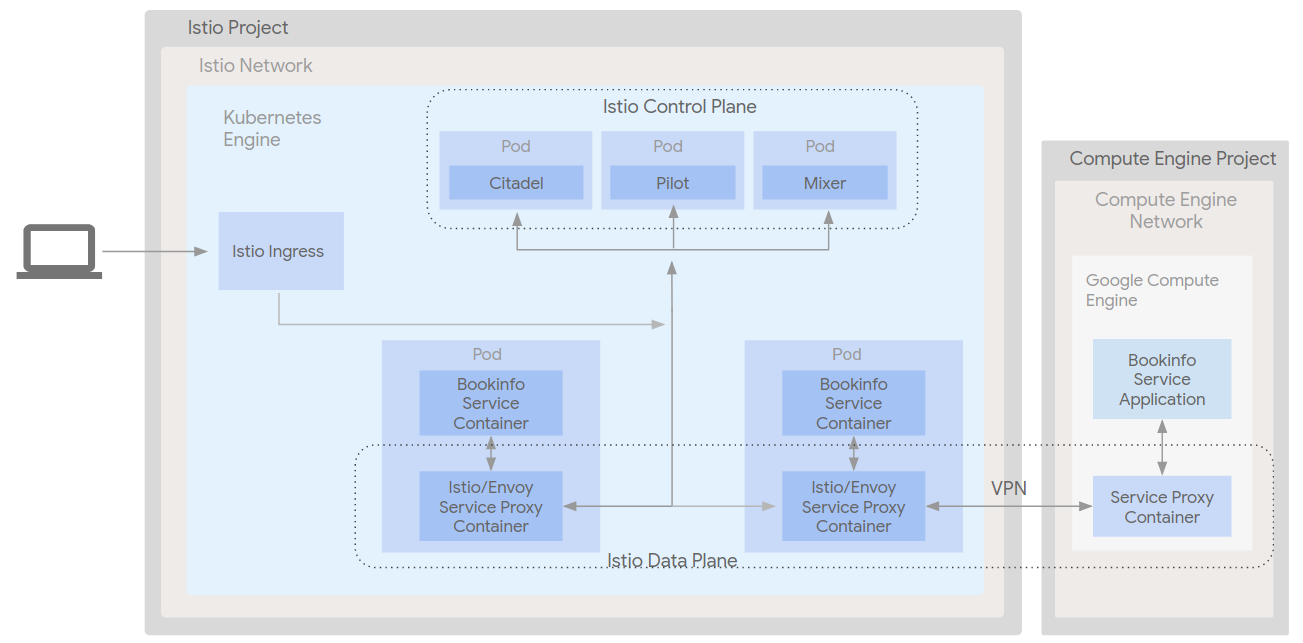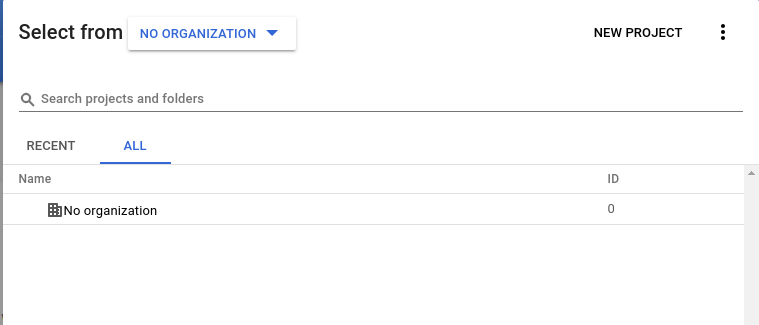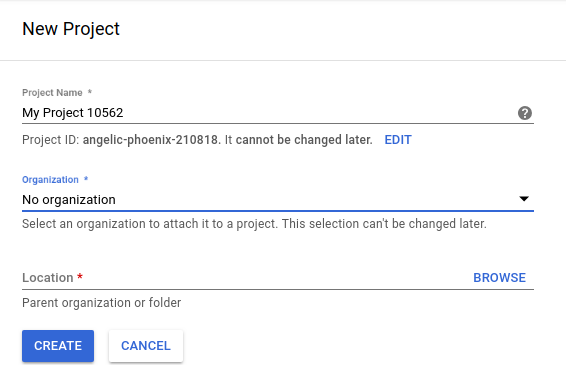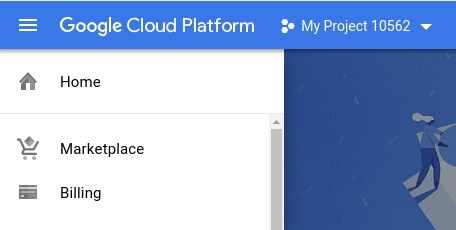- Introduction
- Architecture
- Prerequisites
- Creating a project
- Deployment
- Validation
- Tear Down
- Known issues
- Troubleshooting
- Relevant Material
Istio is part of a new category of products known as "service mesh" software designed to manage the complexity of service resilience in a microservice infrastructure; it defines itself as a service management framework built to keep business logic separate from the logic to keep your services up and running. In other words, it provides a layer on top of the network that will automatically route traffic to the appropriate services, handle circuit breaker logic, enforce access and load balancing policies, and generate telemetry data to gain insight into the network and allow for quick diagnosis of issues.
For more information on Istio, please refer to the Istio documentation.
This repository contains demonstration code for Istio's mesh expansion feature between resources in two Google Cloud Platform (GCP) projects connected via VPN. The feature allows for a non-Kubernetes service running outside of the Istio infrastructure on Kubernetes Engine to be integrated into and managed by the Istio service mesh.
This demonstration will create a number of resources.
- A single (GKE) cluster with IP aliasing turned on in a custom network in project A
- A Google Compute Engine (GCE) instance in a custom network project B
- A VPN bridging the two networks containing the GKE cluster and the GCE instance
- The Istio service mesh installed in the GKE cluster
- The BookInfo application installed in the Istio service mesh
- A firewall rule allowing full SSH access to the GCE instance from any IP address
- A firewall rule allowing full access to the MySQL database from the GKE cluster
In order to use the code in this demo you will need to have have access to a bash-compatible shell with the following tools installed:
- Two GCP projects with billing enabled
- Google Cloud SDK (200.0.0 or later)
- HashiCorp Terraform v0.11.7
- kubectl (v1.10.0 or later)
In order to complete this demo, two proejcts need to exist, one for the GKE cluster and a second for the GCE instance, which will be connected via a VPN.
To create projects:
- Log in to the GCP Console
- click on "Select a project" in the top navigating bar
- Click on "New Project" in on the top right of the window
- Select a project name, and note the project id below it. (in this case, the project id is 'angelic-phoenix-210818')
- Enable billing by clicking on the three lines in the top left corner select "Billing" and enable it
Clone the repository and change directory to the gke-istio-vpn-demo
directory.
The gke-istio-vpn-demo folder is considered the working directory and
all commands should be executed from it.
Open the istio.env file and set
ISTIO_PROJECTto the ID of the project you want to use for Istio infrastructureGCE_PROJECTto the ID of the project you want to use for GCE- The ID of the project is not always the same as the name.
- Any variables you wish to customize
When you are done, save the file and run the install.sh script. You will be
prompted if you want to deploy the infrastructure by Terraform. When you reach
this point, go ahead and type yes.
Do you want to perform these actions?
Terraform will perform the actions described above.
Only 'yes' will be accepted to approve.
Enter a value: yes
This script will deploy all of the necessary infrastructure to correctly run Istio.
-
The GKE cluster uses IP aliasing, without this feature, the demo would not work. IP Aliasing is a feature by which services and pods can have their IP addresses set to values within a specific CIDR block, which allows them to be known in advance of a deployment, and callable by other resources. This also ensures that the IP addresses will not conflict with other GCP resources and provides an additional mechanism for firewall traffic control (eg rules on the pod may differ from those on the underlying host). For more information on IP Aliasing see: https://cloud.google.com/kubernetes-engine/docs/how-to/alias-ips
-
The GKE cluster's IP CIDR blocks are defined in the istio.env file and can be changed in the event that other values are needed (eg if they conflict with other IP address space).
-
Firewall and Routing rules are created at deployment time to facilitate the necessary communication without exposing ports and services unnecessarily.
-
The VPN configuration (endpoints, firewalls and routing rules) are defined in the included terraform configuration (./main.tf). For more information on VPN's see: https://cloud.google.com/vpn/docs/how-to
To validate that everything is working correctly, first open your browser to the URL provided at the end of the installation script. You'll see a BookInfo web site. After taking a look, run:
./validate.sh <STARS>
where is the number of stars to be returned as the rating given by the first review on the product page.
You'll see output similar to
114c114
< <!-- empty stars: -->
---
> <span class="glyphicon glyphicon-star"></span>
116c116
< <span class="glyphicon glyphicon-star-empty"></span>
---
> <span class="glyphicon glyphicon-star"></span>
118c118
< <span class="glyphicon glyphicon-star-empty"></span>
---
> <span class="glyphicon glyphicon-star"></span>
120c120
< <span class="glyphicon glyphicon-star-empty"></span>
---
> <span class="glyphicon glyphicon-star"></span>
122c122
< <span class="glyphicon glyphicon-star-empty"></span>
---
> <!-- empty stars: -->
Refresh the page in your browser, the first rating should reflect the number of stars passed to the validate script. Behind the scenes, the validate script is directly editing the database on the GCE VM that was integrated into the mesh, proving that the BookInfo application is using the database on the VM as the source of the rating data.
To tear down the resources created by this demo, run
./tear-down.sh
You should be prompted by terraform about whether or not you want to tear down the infrastructure. It will look similar to
...
- google_compute_subnetwork.subnet_istio
- google_compute_vpn_gateway.target_gateway_gce
- google_compute_vpn_gateway.target_gateway_istio
- google_compute_vpn_tunnel.tunnel1_gce
- google_compute_vpn_tunnel.tunnel1_istio
- google_container_cluster.istio_cluster
Plan: 0 to add, 0 to change, 24 to destroy.
Do you really want to destroy?
Terraform will destroy all your managed infrastructure, as shown above.
There is no undo. Only 'yes' will be accepted to confirm.
Enter a value:
Type yes to finish tearing down the infrastructure.
- The Istio Mesh Expansion feature does not support mutual TLS authentication
Problem: The Book Reviews section is returning an error stating that the ratings service is not available.
Solution: Istio may still be configuring the mesh. Wait for a minute so while refreshing the page.
Problem: The install script fails with a Permission denied when running
Terraform.
Solution: The credentials that Terraform is using do not provide the
necessary permissions to create resources in the selected projects. Ensure
that the account listed in gcloud config list has necessary permissions to
create resources. If it does, regenerate the application default credentials
using gcloud auth application-default login.
Problem: Loss of GKE cluster network connectivity after 24 hours
Solution: Remove the GCE instance and rerun all steps involving the GCE setup
Problem: The install script times out while waiting for the internal load balancers to finish provisioning.
Solution: Likely the cause is a transient platform issue. Rerun the script as it is idempotent up to this point process and should not run into any issues with infrastructure that already exists.
Problem: The install script gives an error like:ERROR: (gcloud.services.enable) User [{your-email address}] does not have permission to access service [compute.googleapis.com:enable] (or it may not exist): Project '{your-project-name}' not found or permission denied.
Solution: Enter the project Id and not the project name into propeties.env
- https://github.com/istio/community
- https://istio.io/docs/guides/bookinfo.html
- https://cloud.google.com/kubernetes-engine/docs/tutorials/istio-on-gke
- https://cloud.google.com/compute/docs/tutorials/istio-on-compute-engine
- https://istio.io/docs/setup/kubernetes/mesh-expansion.html
- https://istio.io/docs/guides/integrating-vms.html
This is not an officially supported Google product
